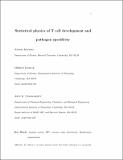Statistical Physics of T-Cell Development and Pathogen Specificity
Author(s)
Kosmrlj, Andrej; Kardar, Mehran; Chakraborty, Arup K
DownloadStatistical physics.pdf (749.4Kb)
OPEN_ACCESS_POLICY
Open Access Policy
Creative Commons Attribution-Noncommercial-Share Alike
Terms of use
Metadata
Show full item recordAbstract
In addition to an innate immune system that battles pathogens in a nonspecific fashion, higher organisms, such as humans, possess an adaptive immune system to combat diverse (and evolving) microbial pathogens. Remarkably, the adaptive immune system mounts pathogen-specific responses, which can be recalled upon reinfection with the same pathogen. It is difficult to see how the adaptive immune system can be preprogrammed to respond specifically to a vast and unknown set of pathogens. Although major advances have been made in understanding pertinent molecular and cellular phenomena, the precise principles that govern many aspects of an immune response are largely unknown. We discuss complementary approaches from statistical mechanics and cell biology that can shed light on how key components of the adaptive immune system, T cells, develop to enable pathogen-specific responses against many diverse pathogens. The mechanistic understanding that emerges has implications for how host genetics may influence the development of T cells with differing responses to the human immunodeficiency virus (HIV) infection.
Date issued
2013-04Department
Massachusetts Institute of Technology. Institute for Medical Engineering & Science; Massachusetts Institute of Technology. Department of Biological Engineering; Massachusetts Institute of Technology. Department of Chemical Engineering; Massachusetts Institute of Technology. Department of Chemistry; Massachusetts Institute of Technology. Department of Physics; Ragon Institute of MGH, MIT and HarvardJournal
Annual Review of Condensed Matter Physics
Publisher
Annual Reviews
Citation
Kosmrlj, Andrej, Mehran Kardar, and Arup K. Chakraborty. “Statistical Physics of T-Cell Development and Pathogen Specificity.” Annu. Rev. Condens. Matter Phys. 4, no. 1 (April 2013): 339–360.
Version: Author's final manuscript
ISSN
1947-5454
1947-5462